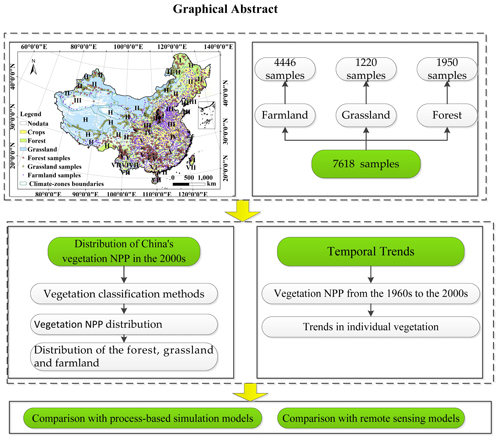Net primary production (NPP) is an important ecological indicator for the terrestrial ecosystem carbon budget which corresponds to the amount of organic matter produced by photosynthesis per unit of time and area, minus autotrophic respiration of vegetation.
Many previous researchers focused on small scales or a single Chinese vegetation ecosystem using field data , and numerous studies at regional scales by remote sensing models avoid validating models with independent observations and the uncertainty of these models. However NPP based on field data for Chinese vegetation, which contains forest, grassland, and farmland ecosystems at the national scale, has rarely been reported, and they also lack long-term time series.
Prof. ZHANG Hongqi's grouop at Key Laboratory of Land Surface Pattern and Simulation, Institute of Geographic Sciences and Natural Resources Research (IGSNRR), Chinese Academy of Sciences compiled field data from the 1960s to the 2000s to analyze spatiotemporal dynamics of the Chinese vegetation net primary productivity. This work was published in Remote Sensing.
They found that NPP ranged from 3 to 12407 gC·m-2·year-1 with a mean value of 571 gC·m-2·year-1. Further studies showed that Vegetation NPP gradually decreased from the southeast to the northwest. Total terrestrial NPP decreased from 3.58 to 3.41 Pg C·year-1. The two periods (1960s–1980s and 1980s–2000s) showed opposite trends, and the decrease in the previous period was greater than the increase in the latter period.
They used multiple models of NPP estimation and vegetation classification methods to study Chinese vegetation NPP characteristics, trends, and drivers using 7618 field measurements from the 1960s, 1980s, and 2000s.
The study shows that forest, farmland, and grassland NPP was 1152, 294, and 518 gC·m-2·year-1. Total NPP in forests and grasslands consistently showed a decreasing trend and decreased by 0.46 Pg C·year-1 and 0.16 Pg C·year-1, respectively, whereas NPP for farmland showed an opposite trend, with a growth of 0.45 Pg C·year-1.
“The distribution of vegetation NPP in China had large spatial heterogeneity and large regionalvariations. It gradually decreases from the southeast to the northwest,” said Prof. ZHANG.
Precipitation, temperature, and solar radiation affect the spatial variability of NPP in the north and south of China. In addition, the effect of precipitation on grassland NPP was higher than temperature and solar radiation, especially for deserts, followed by steppes and meadows.
|

|
|
Figure: Graphical Abstract (Image by Prof. ZHANG Hongqi’s group) |
The work was supported by the Strategic Priority Research Program of the Chinese Academy of Sciences, the National Natural Science Foundation of China and the Strategic Priority Research Program of the Chinese Academy of Sciences.
Reference:
Erping Shang, Erqi Xu, Hongqi Zhang*, Fang Liu, Analysis of spatiotemporal dynamics of the chinese vegetation net primary productivity from the 1960s to the 2000s. Remote Sensing, 2018, 10(6), 860; https://doi.org/10.3390/rs10060860.